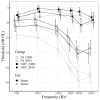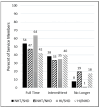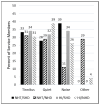Examining the Use and Benefits of Low-/Mild-Gain Hearing Aids in Service Members with Normal Hearing Thresholds and Self-Reported Hearing Difficulties
- PMID: 38470689
- PMCID: PMC10931166
- DOI: 10.3390/healthcare12050578
Examining the Use and Benefits of Low-/Mild-Gain Hearing Aids in Service Members with Normal Hearing Thresholds and Self-Reported Hearing Difficulties
Abstract
Low- (or mild-) gain hearing aids (LGHAs) are increasingly considered for individuals with normal peripheral hearing but significant self-reported hearing difficulties (SHDs). This study assesses the benefits of LGHAs as a management option for individuals with normal hearing thresholds (NHTs) and SHDs, comparing LGHA use and benefit to individuals with non-significant hearing difficulties (NHDs) and those with peripheral hearing loss. Questionnaires addressing hearing aid usage, benefit, hearing difficulties, and tinnitus were administered to 186 individuals who self-identified as hearing aid users in a sample of 6652 service members who were receiving their annual hearing tests. Participants were divided into SHD and NHD groups based on the normative cutoff of the Tinnitus and Hearing Survey-Hearing Subscale (THS-H), and into hearing impairment (HI) and NHT based on their audiometric air-conduction thresholds. Individuals with SHDs and NHTs reported higher LGHA usage and benefit than individuals with NHDs and NHTs. Comparable use and benefit were noted between groups with SHDs regardless of peripheral hearing loss status. The findings support LGHAs as a suitable management option for individuals with NHTs and SHDs, as indicated by hearing aid use and benefit. Quantifying the level of perceived auditory processing deficits (i.e., SHDs), notably with the THS-H, enhances sensitivity in identifying those who may benefit the most from this treatment option.
Keywords: auditory processing; correction of hearing impairment; hearing loss; low-gain hearing aids; management; mild-gain hearing aids; self-reported hearing difficulties.
Conflict of interest statement
The authors declare no conflicts of interest. The funders had no role in the design of the study; in the collection, analyses, or interpretation of data; in the writing of the manuscript; or in the decision to publish the results.
Figures








Similar articles
-
Mild-Gain Hearing Aids as a Treatment for Adults with Self-Reported Hearing Difficulties.J Am Acad Audiol. 2018 Jun;29(6):477-494. doi: 10.3766/jaaa.16111. J Am Acad Audiol. 2018. PMID: 29863462 Clinical Trial.
-
Estimated Prevalence of Functional Hearing Difficulties in Blast-Exposed Service Members With Normal to Near-Normal-Hearing Thresholds.Ear Hear. 2021 Nov-Dec 01;42(6):1615-1626. doi: 10.1097/AUD.0000000000001067. Ear Hear. 2021. PMID: 34108398
-
Rapid Assessment of Subjective Hearing Complaints With a Modified Version of the Tinnitus and Hearing Survey.Trends Hear. 2023 Jan-Dec;27:23312165231198374. doi: 10.1177/23312165231198374. Trends Hear. 2023. PMID: 37822285 Free PMC article.
-
Self reported hearing difficulty, tinnitus, and normal audiometric thresholds, the National Health and Nutrition Examination Survey 1999-2002.Hear Res. 2018 Feb;358:30-36. doi: 10.1016/j.heares.2017.12.001. Epub 2017 Dec 7. Hear Res. 2018. PMID: 29254853
-
The Efficacy of Digital Hearing Aids in the Management of Tinnitus in Individuals with Sensorineural Hearing Loss.Int Tinnitus J. 2021 Mar 1;25(1):100-106. doi: 10.5935/0946-5448.20210018. Int Tinnitus J. 2021. PMID: 34410087 Review.
References
-
- Lasky E.Z., Katz J. Central Auditory Processing Disorders: Problems of Speech, Language, and Learning. University Park Press; University Park, PA, USA: 1983.
-
- Stark R.E., Bernstein L.E. Evaluating central auditory processing in children. Top. Lang. Disord. 1984;4:57–70. doi: 10.1097/00011363-198406000-00008. - DOI
-
- Musiek F.E., Baran J., Bellis T.J., Cherman G.D., Hall J., III, Keith R., Medwetsky L., West K.L., Young M., Nagle S. Diagnosis, Treatment and Management of Children and Adults with Central Auditory Processing Disorder. American Academy of Audiology Clinical Practice Guidelines 2010. [(accessed on 29 January 2024)]. pp. 1–51. Available online: https://audiology-web.s3.amazonaws.com/migrated/CAPD%20Guidelines%208-20....
-
- Iliadou V.V., Ptok M., Grech H., Pedersen E.R., Brechmann A., Deggouj N., Kiese-Himmel C., Sliwiska-Kowalska M., Nickisch A., Demanez L., et al. A European persepctive on auditory processing disorder-current knowledge and future research focus. Front. Neurol. 2017;8:622. doi: 10.3389/fneur.2017.00622. - DOI - PMC - PubMed
Grants and funding
LinkOut - more resources
Full Text Sources

